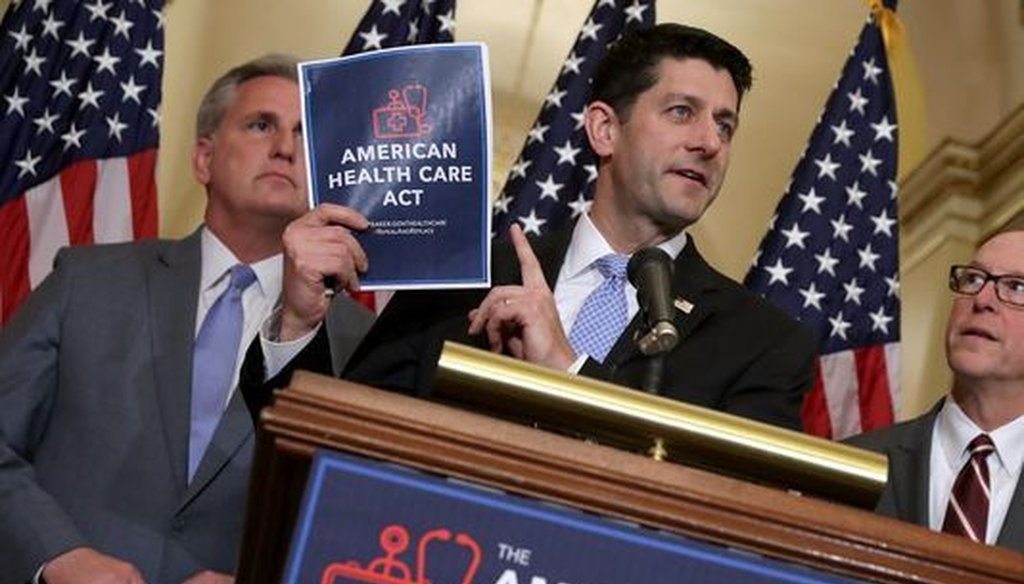

Our only agenda is to publish the truth so you can be an informed participant in democracy.
We need your help.


House Speaker Paul Ryan has touted an estimate that the Republican plan for replacing Obamacare would reduce premiums 10 percent. But there's more to know about that claim. (Getty Images)
Big headlines on March 13, 2017 confirmed what many on the left had feared about the Republicans' proposal for replacing Obamacare:
The American Health Care Act, as the plan is known, would increase the number of uninsured by 24 million by 2026.
That projection was made in a report by the nonpartisan Congressional Budget Office, a gold-standard source for government information.
But people on the right were ready with a response.
In a statement issued the same day, House Speaker Paul Ryan began by making this claim:
"This report confirms that the American Health Care Act will lower premiums."
What we found is: It doesn’t, and then it does.
And there’s more to the story.
The report
Let’s start off by making it clear that the Wisconsin Republican’s reference is to what is known as the individual or "nongroup" market -- that is, the roughly 7 percent of Americans who buy health insurance on their own because they aren’t covered by an employer or a program such as Medicaid.
Here’s what the report says for those people:
Increases: In 2018 and 2019, average premiums would be 15 percent to 20 percent higher than under Obamacare, formally known as the Affordable Care Act.
That’s mainly because the penalties under Obamacare for not getting insurance would be eliminated, "inducing fewer comparatively healthy people to sign up."
Decreases: Premiums would start to drop in 2020. And by 2026, the premiums, on average, would be 10 percent lower than they would have been under Obamacare.
That’s expected for several reasons: The GOP legislation would provide grants to states that could be used to reduce premiums; the bill would eliminate a requirement for insurers to offer plans covering certain percentages of health care expenses; and a younger mix of enrollees.
While on average premiums are expected to eventually be 10 percent lower, the impact on different groups of people would be wide ranging.
Under Obamacare, a 64-year-old can generally be charged premiums that cost up to three times as much as those offered to a 21-year-old. But under the GOP bill, it would be five times as much, unless a state chose otherwise.
So, by 2026, premiums are projected to be 20 percent to 25 percent lower for a 21-year-old and 8 percent to 10 percent lower for a 40-year-old — but 20 percent to 25 percent higher for a 64-year-old.
Some examples, for a people who earn $26,500 per year in 2026:
The annual premium for a 21-year-old would be $5,100 under Obamacare, but only $3,900 under the GOP plan. For a 64-year-old, the premiums would be $15,300 under Obamacare vs $19,500 under the GOP plan.
Finally, it’s important to look beyond what premiums will do.
The report points out that compared to Obamacare, the GOP plan would require insurance plans to cover a lower percentage of total costs -- the insurance plans would have a lower "actuarial value," so lower premiums would be buying less coverage. For example, a person’s deductible is expected to be higher than under Obamacare.
Our rating
Ryan says a report from the nonpartisan Congressional Budget Office "confirms that the American Health Care Act will lower premiums."
His reference is to people who buy health insurance on their own, rather than getting it from an employer or a government program such as Medicaid -- and how the Republicans’ American Health Care Act compares to the existing Affordable Care Act.
For those people, the report expects average premiums would be 15 percent to 20 percent higher in 2018 and 2019, but by 2026 would be 10 percent lower. And the report also says that out-of-pocket expenses, such as deductibles, would tend to be higher than under Obamacare.
For a statement that is partially accurate but leaves out important details, our rating is Half True.
WisPolitics, Paul Ryan news release, March 13, 2017
Congressional Budget Office, American Health Care Act cost estimate, March 13, 2017
Email, Paul Ryan press secretary Ian Martorana, March 13, 2017
Center on Budget and Policy Priorities, "CBO: Millions Would Pay More for Less Under House GOP Health Plan," March 13, 2017
Interview, Tax Policy Center Sol Price fellow Roberton Williams, March 14, 2017
In a world of wild talk and fake news, help us stand up for the facts.
